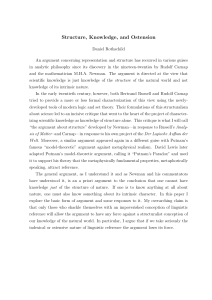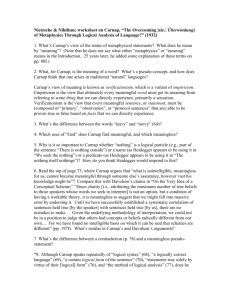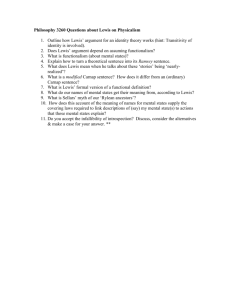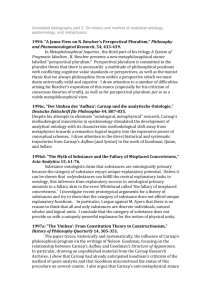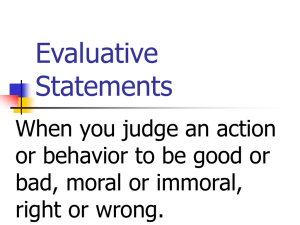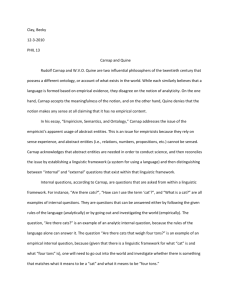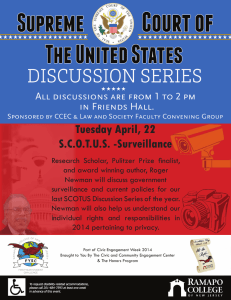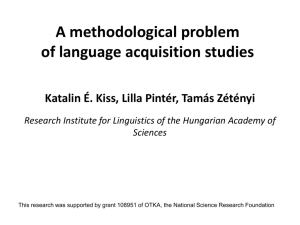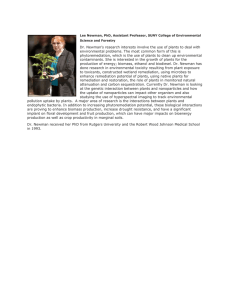Structure, Knowledge, and Ostension
advertisement
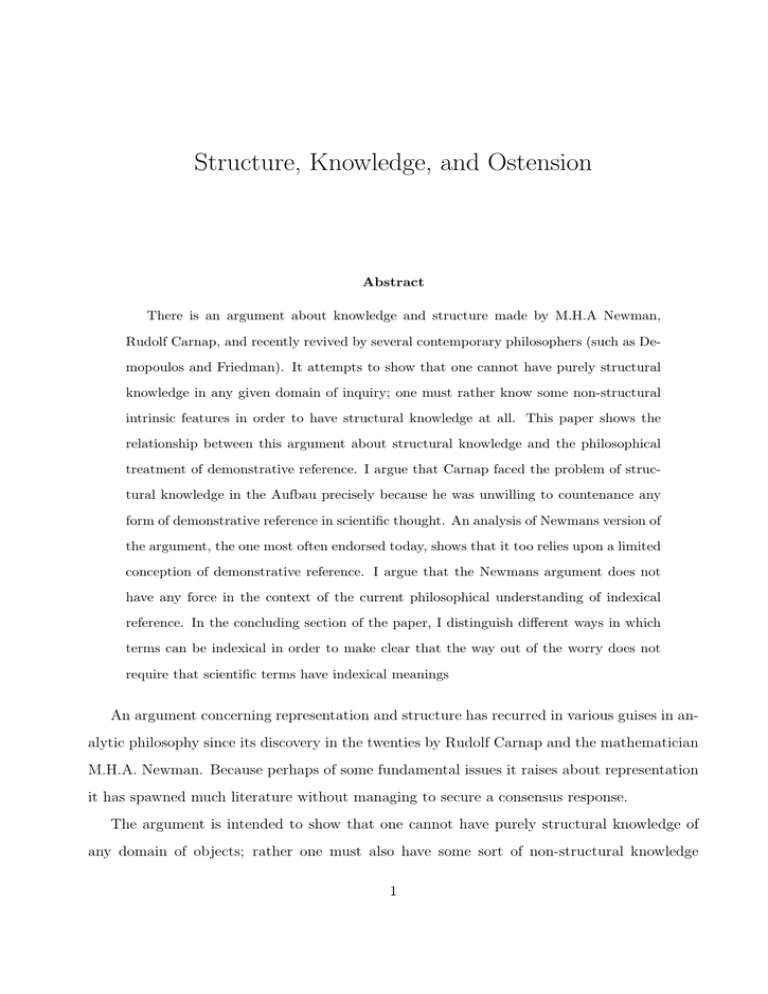
Structure, Knowledge, and Ostension Abstract There is an argument about knowledge and structure made by M.H.A Newman, Rudolf Carnap, and recently revived by several contemporary philosophers (such as Demopoulos and Friedman). It attempts to show that one cannot have purely structural knowledge in any given domain of inquiry; one must rather know some non-structural intrinsic features in order to have structural knowledge at all. This paper shows the relationship between this argument about structural knowledge and the philosophical treatment of demonstrative reference. I argue that Carnap faced the problem of structural knowledge in the Aufbau precisely because he was unwilling to countenance any form of demonstrative reference in scientific thought. An analysis of Newmans version of the argument, the one most often endorsed today, shows that it too relies upon a limited conception of demonstrative reference. I argue that the Newmans argument does not have any force in the context of the current philosophical understanding of indexical reference. In the concluding section of the paper, I distinguish different ways in which terms can be indexical in order to make clear that the way out of the worry does not require that scientific terms have indexical meanings An argument concerning representation and structure has recurred in various guises in analytic philosophy since its discovery in the twenties by Rudolf Carnap and the mathematician M.H.A. Newman. Because perhaps of some fundamental issues it raises about representation it has spawned much literature without managing to secure a consensus response. The argument is intended to show that one cannot have purely structural knowledge of any domain of objects; rather one must also have some sort of non-structural knowledge 1 in order to have structural knowledge. In the first part of the paper, I claim that that the argument depends upon an inadequate idea of linguistic reference, and that once we recognize the potential for ostensive reference the argument loses its force. In the second part of the paper, I attempt some general remarks on the role of ostension, as opposed to description, in linguistic reference. I distinguish the semantics of ostensive expressions from the role ostension plays in determining the meaning of expressions. 1 Problems of Structure The argument I’ll discuss was independently described by by Carnap and Newman in 1928.1 Newman objected that Bertrand Russell’s account of scientific knowledge as structural knowledge was unstable. Carnap realized that the project of treating all scientific knowledge as knowledge of the structure of experience was incomplete without adding a postulate that his framework would not allow. The reasoning that led them to these problems was markedly similar. Moreover, a similar argument appeared again in a different guise in what has become known as Putnam’s paradox.2 Carnap and Russell both discussed representations which worked by having a structure isomorphic to the structure of the thing represented. In the Aufbau Carnap attempted to use a set-theoretic construct to model the totality of our experience. For Russell (1927) accurate scientific representation had structures isomorphic to those in nature.3 The notion of isomorphism is simple. Consider both the representation and the represented to be domains of objects with various properties and relations over them. There is accurate representation if there is a one–to–one function f that goes from the representation to the represented and preserves structure in the following sense: Isomorphic Representation with respect to f For any two-place relation R in the rep1 2 In Carnap (1928) and Newman (1928). Putnam’s original argument appears in Putnam (1978). Demopoulos and Friedman (1985) show the intimate relation between his problem and that raised by Carnap and Newman. 3 See Demopoulos and Friedman (1985) for discussion of Russell’s idea of representation as isomorphism. 2 resentation there is a relation S in the represented such that for any objects x, y : xRy ⇐⇒ f (x)Sf (y).4 In other words, one thing represents another just in case there’s a way of seeing it as having the same structure of relations over it as over what it represents. Newman and Carnap both saw a problem with claiming that all one knows of something is that it has such an isomorphism with a set-theoretic representation. Here is the problem. One way of describing what one knows is that the represented domain has a structure which is isomorphic to the structure of the representation. But this knowledge itself is trivial as long as the cardinality of the representation and the represented are the same. Given any representation with a system of relations over it there is an easy way to show that it is an accurate representation of something else. First take some 1-1 function, f , from the representation to the represented (which is possible as long as the cardinality of the two are the same). Then, for all the relations in the representation their images in the represented with respect to f will have to exist—that’s just a matter of set theory. But these images are just what is needed to satisfy the Isomorphic Representation condition above. So any representation, up to having the right cardinality, is successful. Here’s a trivial example. Suppose my representation has three objects, x, y, and z and one relation R which holds only just for the pair z,y. Having this representation of some real world domain could be an example of having “structural knowledge”. However, the problem is that the knowledge encoded by this representation is trivial. This is because any mapping of this representation onto three real world objects will allow a correspondence from R to a relation in the real world; all you need to do is pick one pair of objects and take the relation over them. So, whatever the three objects in the real world are like, the representation will be accurate. The problem is that all possible relations among objects in the real world trivially exist: as long as we identify relations simply by their set-theoretic constructs, then such constructs must exist. Thus, if one does not know something more about which relations one is talking about, then one cannot make a non-trivial claim about structure. 4 Of course, this definition must be expanded for n-ary relations rather than just two-place relations. 3 Newman concluded that you need to know something about the intrinsic nature of the relations in nature, not just the structure of them. Carnap realized that the entire system of the Aufbau needed to be augmented with a basic property which picks out the right relations, what he called the “founded” relations. I will look back on Carnap’s project in the Aufbau and explain why the problem he faced was so deadly for him. In the process I will flag the particular assumptions he made that allow the argument to affect his project. Then I will examine the general form of the argument of structural knowledge as Newman presented it. Here, I’ll try to show that one has to have an impoverished notion of linguistic reference—something Carnap and Russell shared—to be bothered by the argument. After this I’ll indicate how we can think about the role of ostension in meaning and the fixing of meaning. 2 Carnap’s Problem Carnap encountered a serious and real problem when he discovered the argument against pure structural knowledge that I sketched above. The reason that he had to face this problem was that he wanted to represent scientific knowledge in a way that would entirely eliminate any reliance on ostensive reference. Carnap writes that an ostensive description is one where “the object which is meant is brought within the range of perception and is then indicated by an appropriate gesture, e.g. ‘That is Mont Blanc”’ (Carnap, 1928, §13). What he means is something even broader than this indicates. For any description is ostensive if it uses some term which itself can only be given an ostensive description. In the Aufbau, Carnap’s project—comic now in its ambition—was to define every possible object of scientific inquiry by non-ostensive description of the structure of experiences. The details will take us too far afield, but here is the basic story. Carnap assumed that experiences were discretely divisible and that there existed a resemblance relation between different experiences. Thus, we can think of experiences as the members of a set with a two-place relation, R, over it. His overarching thesis is that we can analyze scientific claims as speaking only about the structure of this relation. 4 To see how strict Carnap’s constraint of eliminating ostensive reference was it is useful to look at a famous passage where he considers giving a structural description of the Eurasian rail network. He is discussing the possibility of identifying all the points of connection on the rail network merely by the structural features of the relations over them. If two points are not distinguishable they are “homotopic”: No one will suppose that there can still be two points which are homotopic under all of the relations we have introduced [i.e. about the rail stations and their connections]. However, such a case merely contradicts our notion of what actually exists, but it is not altogether unimaginable. Thus, in order to solve the problem in principle, we must still pose the further problem: how can we produce a [purely structural] definite description if all these relations do not suffice. So far we have utilized only spatial relations, since their schematic spatial representation is both customary and easily understood. But we can also employ other geographic relations and establish a connection between number of inhabitants. . . . if we are still left with two homotopic elements of the object domain, then we still have two locations that are geographically indistinguishable. If we then move on to a new type of relation and take into account all the historic relations. . . we shall ultimately have used up all the concepts of cultural as well as physical sciences. If there should still be two locations for which we have found no difference even after exhausting all available scientific relations, then they are indistinguishable, not only for geography, but for science in general. They may be subjectively different: I could be in one of these locations, but not in the other. But this would not amount to an objective difference, since there would be in the other place a man just like myself who says, as I do: I am here and not there. (Carnap, 1928, §13) Indexical descriptions are ostensive, and so cannot be used to distinguish between different points. This leads Carnap to the dramatic conclusion that those things which can only be distinguished indexically are not really different—they are only subjectively different. 5 In this context we can see how severe the problem of structural knowledge was for Carnap. Carnap wants to establish that “science deals only with the description of structural properties of objects” (§13). To do this, Carnap tries to represent all of scientific knowledge in a way that does not use any ostensive descriptions. However, his project starts by ostensively identifying the relation of resemblance between experiences. Carnap is well aware that this foundation is inadequate. After he has done the work of identifying the content of scientific claims in terms of the resemblance relation, he tries to then eliminate ostensive reference to the relation (§153–155). In these sections (strangely labeled “may be omitted”), he defines the resemblance relation as the one which would satisfy all the structural claims of scientists. This comes down to identifying the resemblance relation purely by its set-theoretic structure. If one does this, however, then scientific claims only come down to the statement that there exists a relation over the objects in the world with such and such a structure. However, Carnap is aware that this will not work owing to the fact that many gerrymandered relations over experiences (or other objects) will have the same structure as science attributes to the resemblance relation over experiences. So scientific claims have become trivially satisfied, all relations over a set of a given cardinality trivially exist.5 This realization is just the problem of structural knowledge I described above. One cannot identify a relation solely on the basis of its structure. It is axiomatic of the set-theoretic tools we use to describe these situations that for any given structure many relations of sharing that structure exist. So one must use something more to identify them. Carnap, however, explicitly disallows using anything like ostensive reference to identify them. Thus, his only recourse is to postulate some basic property: one possessed by the right relations but not by the other, gerrymandered, relations. This property he calls “foundedness” (§155). This move, however, is ad hoc and unsatisfying. For the problem arises that this property, foundedness, seems to be identified only by ostension? So, the quest to eliminate ostension from scientific inquiry ends in failure. 5 Or if scientific claims are taken to be Russellian descriptions, and so assert both existence and uniqueness, they will always be false since uniqueness is guaranteed to fail. 6 3 The Knowledge Argument We saw how the problem of structural knowledge was fatal within Carnap’s strictly nonostensive framework. However, there is a tradition stemming from Newman (1928) which suggests that the problem is of more general application. Newman’s reasoning has been endorsed by Demopoulos and Friedman (1985), Psillos (1999, p. 61–69), Ladyman (1998) and other philosophers. The general claim is that it is not possible to just know the structure of the natural world; one must also know properties that go beyond structural properties. To give one quotation, here is Demopoulos and Friedman (1985, p. 630) endorsing Newman’s argument: The conclusion Newman draws from this analysis is, we think, the right one: since it is indisputably true that our knowledge of structure is non-trivial—we clearly do not stipulate the holding of the structural properties our theories postulate—it cannot be the case that our knowledge of the unperceived parts of the world is purely structural. [their emphasis] It would be an impressive achievement of philosophical reasoning if such a strong claim about the limits of knowledge could be established. I think, however, that the argument for the claim rests upon a naı̈ve conception of language. For simplicity’s sake, let’s just assume that what we are talking about is the structure of one relation over some set S of objects, as in the Aufbau’s treatment of experiences and the resemblance relation. What Carnap and Newman realized is that one cannot speak of these relations simply by saying something of the following form: Over the set S, there exists a relation R s.t. R has such and such a structure. That would be a trivial statement. Rather, to say something non-trivial, one has to refer to the relation R and say of it that it has a certain structure. To make a non-trivial structural claim one has to first set the topic—one must be speaking of some particular relation or class of relations. 7 The argument in question is meant to show that one cannot just know the structure of X (for this case, read: the structure of some relations over X); one must also know something else about X (for this case, read: something else about the relations on X). This claim seems right to the extent that one cannot know anything about the structure of some relation without an independent grasp on which relations one is speaking of. However, this leaves with the critical question: must such a grasp amount to knowledge of non-structural features? A brief consideration of some critical cases in the philosophy of language will show us that the answer is a resounding “no”. Consider for instance, self-predication. To know of yourself that you are in pain, you need have no grasp of who you are. That is, you can simply know that you are in pain while, because of amnesia, know nothing else at all about who you are. This case in mind, let us review Newman’s actual argument: These statements [i.e. Russell’s structuralism] can only mean, I think, that our knowledge of the external world takes this form: The world consists of objects, forming an aggregate whose structure with regard to a certain relation R is known, say W, but of the relation R nothing is known (or nothing need be assumed to be known) but its existence; that is, all we can say is, “There is a relation R such that the structure of the external world with reference to R is W”. Now I have already pointed out that such a statement expresses only a trivial property of the world. Any collection of things can be organized so as to have the structure W, provided there are the right number of them. Hence the doctrine that only the structure is known involves the doctrine that nothing can be known that is not logically deducible from the mere fact of existence, except (“theoretically”) the number of constituting objects. (Newman, 1928, p. 144, Newman’s emphasis) We can see that Newman assumes Russell’s claim about scientific knowledge is a claim of the existence of such a relation. Once we drop that assumption, and instead assume that scientists are speaking of a particular sort of relation (or class of relations) Newman’s argument falls apart. 8 How, one might wonder, can we speak of something without knowing anything about it? This is the wrong question, however, since we do know something about it, namely its structure. It’s not a condition on reference that we know uniquely identifying information about anything we can refer to. In general, our knowledge bottoms out at what might be called indexical knowledge. For example, knowledge that the box in front of me is here, now, may uniquely pick out a box. However, surely, that does not rely on my ability to uniquely identify myself or the box by non-indexical descriptions. Likewise we can see scientific practice as form of activity that yields reference to certain sorts of relations. These cannot be picked out by any identifying descriptions; rather, they can be picked out by simply the fact that they are those relations the scientists are investigating. We might call this picking-out a form of ostension, but we have to expand that concept beyond its typical understanding. Consider the case where you use a map. You can locate yourself on the map by pointing to a spot and saying I am here. But what about the orientation of the map? There is no one act of pointing to establish the orientation of the map. Rather you establish this implicitly by your use of the map, yet nonetheless in a broad sense this is an ostensive act. It is this form of implicit ostension by practice that I claim scientists engage in when they refer to scientific kinds. Given this situation Newman’s claim is in rough waters. He can adopt one of two supplementary assumptions to allow his argument to go through: 1. To speak of anything one needs a completely identifying, indexical-free, definite description. 2. Reference through demonstrative or indexical means always requires some sort of nonstructural knowledge of the thing referred to. The first option is clearly untenable. The fact that Carnap held this as a methodological goal made the problem of structural knowledge real to him, but it cannot be taken seriously today. The second option is more complex. It seems intuitive that reference to many things in everyday life requires lots of non-structural knowledge of them. First, we have to put thought the idea that we must know that we are speaking of something when we are speaking 9 it and this this amounts to non–structural knowledge of it. This is not knowing anything about something intrinsically, just knowing a contingent extrinsic relation it has. You might nonetheless think that one can rarely (perhaps never) refer to a visually presented object without knowing something about how it appears—and it is unclear how to think about what appearances reveal as just structural. However, Russell and Newman are talking about fundamental scientific relations. With them it is not clear even what non-structural information means. It would be strange, on the basis of a tenuous analogy, to suppose that in order to refer to fundamental scientific relations we need to know something about them besides their structure. I conclude that it is unclear how the problem of structural knowledge can be compelling when ostensive reference is allowed. Of course, this response depends upon allowing ostensive reference to objects which are not simply objects of sense-experience. Since Russell could not countenance such reference, Newman’s problem might indeed be worrying for him. 4 The Semantics and Foundational Semantics of Indexicals My discussion above of structural knowledge makes much use of the concept of ostensive reference, something typically associated with indexicals and demonstratives. Appealing to ostension or indexicality in philosophical context often engenders confusion. One might worry, in particular, that the claim I have made commits one to the idea that scientific terms have demonstrative meanings, which seems on the face of it implausible. One reason for this confusion is that a critical distinction is often glossed over or ignored. I call it the distinction between foundational semantics and plain semantics. Foundational semantics is the study of the facts that go into determining the meaning of various forms of representations. Plain semantics is the study and representation of the meanings of various forms of representations. 10 It studies the content of representation without studying what facts determine content.6 In this section, I’ll use this distinction to clarify what sort of ostensive nature I am attributing to scientific terms. When I suggest one can only make ostensive reference to the relations spoken of in science I am making a claim about the foundational semantics of scientific claims, not the plain semantics. In other words, I don’t think we should treat scientific statements as indexical, or as containing hidden indexicals in their semantic representation. Rather we should recognize that various indexical forms of reference play a part in the story of how scientific terms come to mean what they do. In the rest of this section, I will clarify what it means for something to have an indexical foundational semantics without being semantically indexical. (I will freely interchange the terms “ostensive” “demonstrative” and “indexical” here.) Semantic representations are tools that we use to model the content of our representations (scientific, linguistic, mental or whatnot). We can, for instance, model some aspect of the knowledge we gain by science by a set-theoretic model.7 Thus we could say that our theory of dynamics has as part of its content that nature has such and such a structure. In doing so, however, we are making a claim about the content of the theory, not about the way in which the theory comes to have that content. We leave it open that theory may come to have such a content in part by various ostensive acts of identification on the part of the people putting forth the theory. Certain sorts of thoughts and sentences allow for a semantic representation of their indexicality or ostension. Typical representations include centered-possible worlds or indexical “modes of presentation”. Centered-possible worlds are possible worlds with one particular spot marked as the center. Normally, sets of ordinary possible worlds are used to represent the content of an expression. But no obvious set of worlds represents the content of a proposition like the one expressed by the sentence “It is cold here”. Obviously any world representing the content of such a sentence would need to have at least one cold place in it. However, the 6 The distinction is made especially clear by Stalnaker (1997) who attributes the distinction to Kripke (1972). 7 As in, for example, van Fraassen (1980, ch. 3). 11 set of worlds with one cold place in them does not seem to capture the meaning of “It is cold here”. But one can expand the machinery of possible worlds to deal with this problem. This is done by taking worlds to have centers representing the location of the “subject”. Using this tool one can represent “It is cold here” as being the set of all possible worlds with a cold spot in the center.8 This type of semantic representation is one uniform system for capturing the indexical character of certain thoughts. Such systems tend to be used to capture indexical thoughts that have linguistic constituents like “I”, “here”, “now”. These are semantic representations of indexicality or ostension. Carnap’s notion of what makes a statement ostensive went far beyond statements which included words like “I”. For Carnap the proposition that Mt. Blanc is the highest mountain might be ostensive. But, we can easily imagine representing this proposition in possible worlds terms as the set of all possible worlds where Mt. Blanc is the highest mountain. We do not generally think of the statement as semantically indexical. One way of fleshing out Carnap’s idea is to stipulate that singular terms are generally short for elaborate descriptions. This allows for a means of determining whether a singular term is ostensive. What we assume is that there is a primitive vocabulary in terms of which everything is ultimately defined; some parts of this vocabulary are ostensive and some are not. Now, a term is ostensive just in case it is short for a description whose primitive terms are entirely non-ostensive. At least two things make this approach inadequate. One is that it assumes that “Mt. Blanc” and such singular terms are covert description, something most philosophers would not accept today. The second is that it does not distinguish between semantics and foundational semantics. Once we make this latter distinction we can give a Carnapian notion of being foundationally indexical which does depend on the idea that names are semantically equivalent to descriptions. First the intuitive notion: a term is foundationally indexical just in case one’s only means 8 See “Attitudes De Dicto and De Se” reprinted in Lewis (1983) for fuller discussion of these issues. 12 of using it is ultimately through some form of demonstrative thought. Here’s a simple example. I meet a woman next to me while watching the musical Cats. I learn her name is Susan. I thus acquire the referring term “Susan”. Yet it seems the only way I can succeed in doing that is through my ability to think of that woman who maliciously woke me up during Cats to introduce herself as Susan. In this case my term “Susan” is foundationally indexical since my mastery of the term depends upon a demonstrative thought. Formally, this definition of foundationally indexical terms is much like Carnap’s. A term is foundationally indexical if the explanation of how it gets its meaning ultimately relies on some form of demonstrative thought. We replace the idea of a primitive vocabulary with the more familiar notion that all linguistic uses depend on thoughts of various sorts. This, of course, leaves open the question of what makes a thought demonstrative or not. In some sense, it is intuitively clear but I’ll sharpen it up. Doing so, however, depends on using some sort of general theoretical framework for describing thought. I’ll describe what it is for a thought to be demonstrative on both externalist and internalist conceptions of thought. First, here’s brief explication of the externalism/internalism divide: On the former view, thoughts are not merely internal mental states but constitutively involve objects outside the head. On the latter view having a thought depends just on having a certain internal mental state (which determines “narrow content”), though thoughts may derivatively have contents which involve external objects (i.e. “wide content”). For externalists, like Putnam and Stalnaker, demonstrative thoughts are thoughts which are object-dependent, and having a thought is a matter of being appropriately related to an object in some way which is not purely epistemic. A purely epistemic relation between an agent and an object does not depend upon any causal or spatio-temporal relations between the object and the agent. It might instead depend on the agent having some description formulated in general terms of some sort. Again the key issue is whether one is thinking about some objects in a way that is only mediated by general concepts, or whether one is thinking about the object partly in virtue of bearing some more direct, physical relation to the object itself. For internalists, like Lewis, the distinction between demonstrative and non-demonstrative 13 thought may be drawn somewhat differently. One could think of it this way: A demonstrative thought is one whose full, wide content is in some sense dependent on the context of the agent having the thought, not just on the internal thought properties. A non-demonstrative thought does not depend in that way on context. When I have the thought, “2+2=4” the content of that thought just depends on the internal properties in my head, not in anyway on my location, interests or anything like that—at least so an internalist might plausibly claim. On the other hand, when I have the thought “The man in front of me is wearing a really hideous shirt” the wide content of my thought varies depending on my location and orientation. (There is also a sense in which it doesn’t—that is, there is always the context-invariant narrow content.) However, with “2+2=4” it might plausibly be claimed that narrow and wide content are identical. When some internal mental property allows any agent to have a thought such that the narrow and wide content are identical, then that thought is foundationally non-indexical. We can imagine beings that do not have an indexical foundational semantics. These beings might have some basic stock of concepts which they have indexical-free mastery of. They think and communicate by forming representations out of these concepts. The content of their thought in no way depends upon their circumstances. Perhaps we can think of such beings as having epistemic contact with physical things in the same way that we have epistemic contact with logic and mathematics. We are not like this, however. Our knowledge is rooted in our own location and interests. Foundationally indexical thoughts utilize these to allow us to speak of things for which we do not know identifying descriptions which rely only on basic, non-demonstrative concepts. We talk of our location without knowing where we are; we think of ourselves without knowing anything about ourselves; we talk of objects in front of us without knowing much about them. It is reasonable to suppose that we pervasively rely on foundationally indexical representations. It is worthwhile relating this idea to some well-known work on natural kind terms (e.g. Putnam (1975) and Kripke (1972)). Both Kripke and Putnam argue that our ability to speak of natural kinds does not depend on us holding descriptions which uniquely pick them out. Rather there must be some non-epistemic grasp—some way in which our reference to natural kinds depends not just on what we believe about them but also on our having made some 14 sort of ostensive reference to them in our practice. I think the only reasonable interpretation of Putnam’s controversial claim that natural kind terms are indexical is in the foundational semantics sense that I put forward here. The indexical foundational semantics of our representational capacities explains how we can think of things without uniquely identifying them. While some forms of indexicality, such as that of words like “I”, “here”, and “now”, admit of easy semantic representation, other kinds may not.9 Let me relate this view of semantics, which I take to be a standard contemporary view, to the earlier worries about structural knowledge from Newman and Carnap. The argument from structural knowledge was meant to show that to know something about the basic features of the world one must know something about them beyond their structure. This argument worked for Carnap because he wanted to eliminate all indexicality, foundational or semantic, from scientific knowledge. However, anyone who can countenance the foundational indexical nature of scientific reference need not be particularly bothered by this worry. For one may refer to scientific objects not just by knowing things about them but also ostensively. Moreover, such ostensive means of knowledge does not require us to think of the meaning of scientific terms as themselves ostensive. References Carnap, Rudolph (1928). Der Logische Aufbau der Welt. Weltkreisverlag. Chalmers, David (2002). “The components of content.” In “Philosophy of Mind Classical and Contemporary Readings,” Oxford. Demopoulos, William and Friedman, Michael (1985). “A critical notice: Bertrand Russell’s The Analysis of Matter : its historical context and contemporary interest.” Philosophy of Science, 52:621–639. 9 Two-dimensionalism might be understood as an attempt to semantically represent all indexicality (see, for instance, Jackson, 2000; Chalmers, 2002). 15 Jackson, Frank (2000). From Metaphysics to Ethics: A Defence of Conceptual Analysis. Clarendon Press. Kripke, Saul (1972). “Naming and necessity.” In Gilbert Harman and Donald Davidson, eds., “Semantics of Natural Language,” pages 253–355. D. Reidel Publishing Co., Dordrecht. Ladyman, James (1998). “What is structural realism.” Studies in History and Philosophy of Science, 29:409–424. Lewis, David (1983). Philosophical Papers, Vol.I. OUP. Newman, Maxwell H. A. (1928). “Mr. Russell’s ‘Causal Theory of Perception’.” Mind, 37:137–148. Psillos, Stathis (1999). Scientific Realism: How Science Tracks Truth. Routledge. Putnam, Hilary (1975). “The meaning of ‘meaning’.” In K. Gunderson, ed., “Language, Mind, and Knowledge,” University of Minnesota Press. Putnam, Hilary (1978). “Realism and reason.” In “Meaning and the Moral Sciences,” pages 123–140. Routledge. Russell, Bertrand (1927). The Analysis of Matter. Paul Kegan. Stalnaker, Robert (1997). “Reference and necessity.” In Bob Hale and Cripsin Wright, eds., “A Companion to the Philosophy of Language,” pages 534–554. Blackwell. van Fraassen, Bas (1980). The Scientific Image. Oxford University Press. 16
